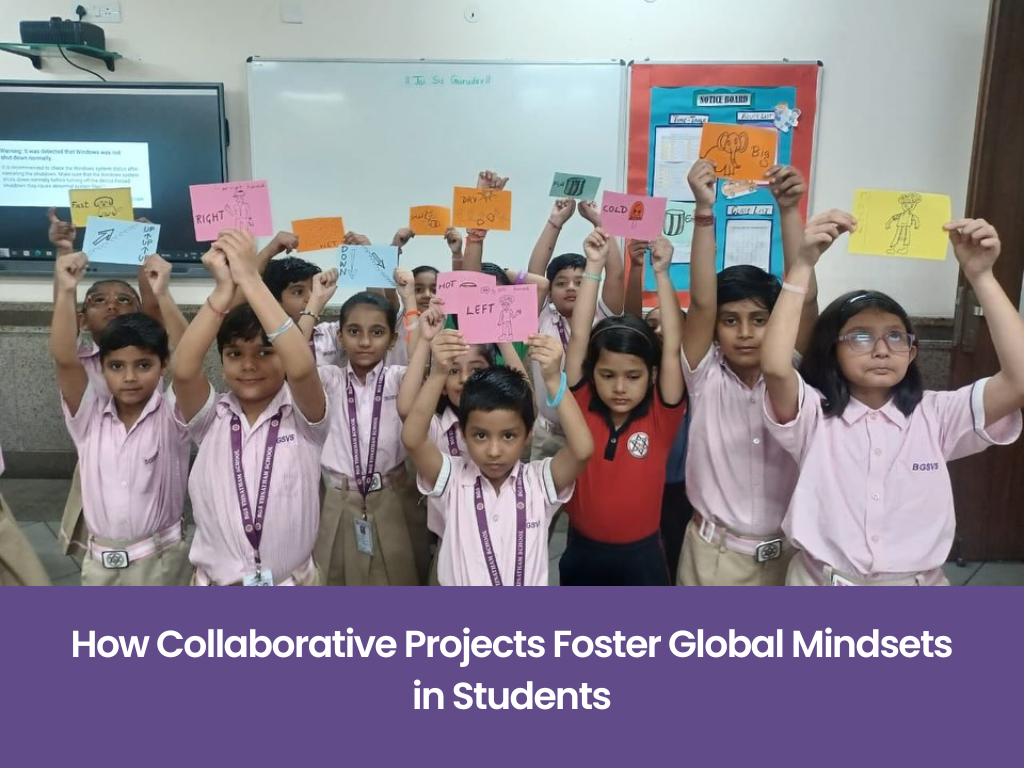How Collaborative Projects Foster Global Mindsets in Students
posted on Dec 05, 2024
In today’s interconnected world, fostering a global mindset in students has become a critical aspect of education. BGS Vijnatham School, being one of the best schools in Greater Noida West, believes that collaborative projects play a pivotal role in developing this perspective.

In today’s interconnected world, fostering a global mindset in students has become a critical aspect of education. BGS Vijnatham School, being one of the best school in Greater Noida West, believes that collaborative projects play a pivotal role in developing this perspective. By engaging students in teamwork across diverse cultures, disciplines, and geographies, collaborative projects expose them to a world of ideas and challenges that extend beyond the classroom. These experiences not only prepare students for a globalized future but also instill values like empathy, adaptability, and inclusivity.
What is a Global Mindset?
A global mindset refers to the ability to understand, respect, and work effectively with people from different cultural and social backgrounds. It emphasizes open-mindedness, cultural awareness, and the willingness to embrace diversity. For students, cultivating a global mindset means being prepared to contribute positively in an increasingly interconnected and multicultural world.
The Role of Collaborative Projects in Developing a Global Mindset
Collaborative projects provide a platform for students to engage with peers, mentors, and communities from varied cultural and academic contexts. These projects can take various forms, including:
-
Cross-Cultural Exchange Programs
Connecting students with peers from other countries to work on shared goals, fostering cultural understanding.
-
Virtual Collaboration Projects
Leveraging digital tools to engage with international teams, breaking geographical barriers.
-
Interdisciplinary Challenges
Bringing together diverse perspectives to solve real-world problems, such as environmental conservation or social justice initiatives.
-
Community-Based Projects
Involving local and global communities in projects that address pressing societal issues.
How Collaborative Projects Foster a Global Mindset
-
Exposure to Diverse Perspectives
Collaborative projects introduce students to different viewpoints, helping them appreciate the richness of diversity and expand their horizons.
-
Development of Cross-Cultural Communication Skills
Working with people from varied backgrounds teaches students how to communicate effectively and respectfully across cultural boundaries.
-
Enhanced Problem-Solving Abilities
Collaborative projects encourage students to think critically and creatively, combining ideas from different disciplines and cultures to address complex challenges.
-
Building Empathy and Understanding
Engaging with others’ experiences fosters empathy and reduces stereotypes, preparing students to navigate global interactions with sensitivity.
-
Preparation for the Global Workforce
By collaborating with peers worldwide, students gain valuable teamwork and leadership skills needed in today’s interconnected job market.
-
Fostering Digital Literacy
Virtual collaborations using digital platforms enhance students’ technological proficiency, a critical skill in the modern world.
Examples of Collaborative Projects with Global Impact
-
Environmental Conservation Initiatives
Students from different countries work together on projects like reducing carbon footprints, promoting renewable energy, or protecting biodiversity.
-
Cultural Exchange Programs
Projects that involve sharing traditions, art, and history allow students to appreciate cultural diversity.
-
Global Debate Competitions
Engaging in debates on global issues like climate change, human rights, or technology ethics fosters critical thinking and cultural awareness.
-
STEM Challenges
Collaborative STEM projects, such as designing sustainable solutions for urban development, integrate technology, science, and cultural insights.
-
Social Entrepreneurship
Students team up to create business models addressing global challenges, such as poverty, education, or healthcare.
Challenges in Implementing Collaborative Projects
-
Time Zone and Scheduling Conflicts
Coordinating across different time zones can be challenging for global collaborations.
-
Language Barriers
Differences in language proficiency can hinder effective communication.
-
Technological Limitations
Unequal access to technology can create disparities in participation.
-
Cultural Sensitivity
Misunderstandings may arise due to differing cultural norms and values.
-
Logistical Complexities
Managing large-scale collaborative projects requires careful planning and resource allocation.
Strategies for Successful Collaborative Projects
-
Leverage Technology
Use digital platforms like video conferencing, collaborative documents, and project management tools to streamline communication and coordination.
-
Promote Cultural Sensitivity
Educate students about cultural differences and encourage respectful engagement.
-
Provide Training and Resources
Equip students and teachers with the skills and tools needed for effective collaboration.
-
Foster Reflection and Feedback
Encourage students to reflect on their experiences and provide constructive feedback to improve future projects.
-
Engage Local and Global Partners
Partner with schools, NGOs, and organizations to provide authentic learning experiences and expand the scope of projects.
Conclusion
Collaborative projects are more than just educational activities—they are gateways to fostering global citizens. BGS Vijnatham School, being one of the best schools in Greater Noida West, believes that such projects cultivate critical life skills, cultural understanding, and a sense of global responsibility in students. By engaging in these meaningful collaborations, students are better prepared to navigate the complexities of a multicultural world and contribute positively to global progress. Schools that embrace collaborative projects are not only enriching education but also shaping the leaders of tomorrow.